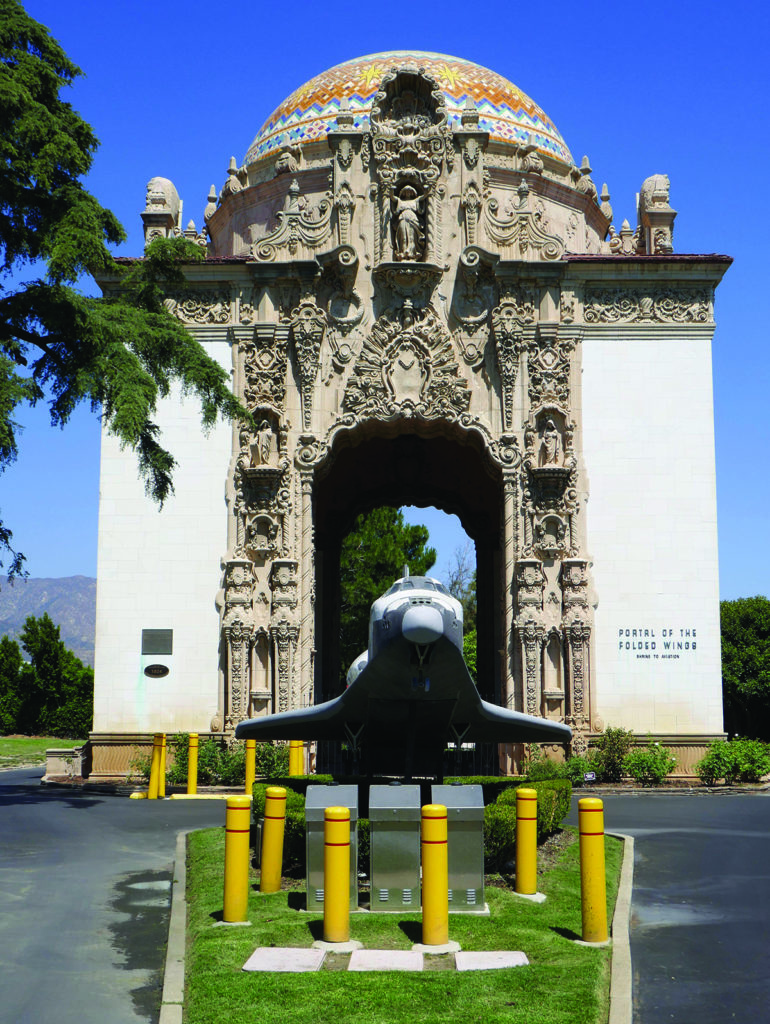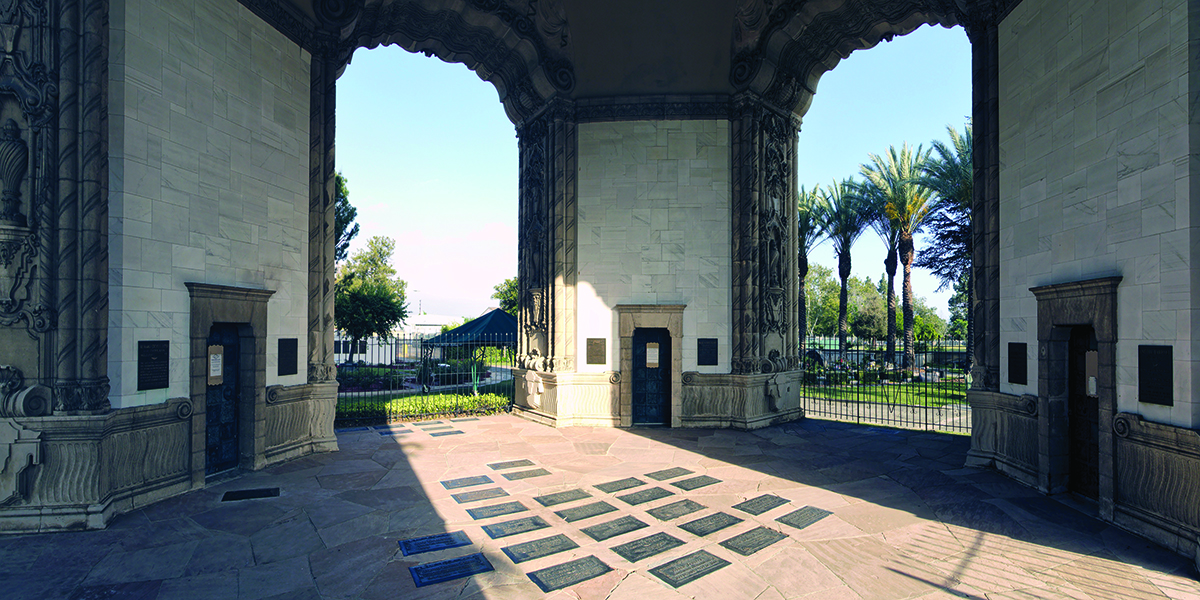All pilots must make that mysterious final flight and leave their mortal remains behind. Some choose to have their ashes scattered over a favorite airfield, while military pilots might land at Arlington National Cemetery in Virginia. So, how did 14 aviation pioneers come to rest beneath a Spanish-style arch in Burbank, California?
Standing just 500 yards from the threshold of Runway 33 at Hollywood Burbank Airport is the Portal of the Folded Wings Shrine to Aviation, a 75-foot-tall Spanish Mission Revival gate built as an impressive entrance to the Pierce Brothers Valhalla Memorial Park cemetery. Erected in 1924 (and added to the National Register of Historic Places in 1998), the portal is large enough to be considered a rotunda, a building with a circular ground plan that is sometimes covered by a dome. This portal has four passages open to the outside, secured by iron gates at night, a colorful tiled mosaic dome and an exterior decorated with ornate stone castings of plants and allegorical figures. The dome’s interior is decorated with stars, an appropriate motif in a memorial to people who loved the sky.

Twenty-nine years after it was built, the portal was dedicated as a resting place and memorial to pilots and other pioneers of flight. The dedication took place on December 17, 1953, the 50th anniversary of the Wright brothers’ first flight at Kitty Hawk. The ceremony included the interment of the ashes of Walter Brookins (1889-1953), the first pilot trained by the Wright brothers for their exhibition team and the first to fly above one mile in altitude. Since then, 13 more aviation pioneers and the portal’s chaplain have been interred under the arch. They include an aircraft mechanic, dirigible pilot, parachute jumper and numerous aircraft designers.
The two earliest figures interred at the shrine are Charles Taylor (1868-1956) and John Moisant (1868-1910). Taylor may be the shrine’s most famous inhabitant, since he built the engine that powered the Wright’s 1903 Flyer and worked as their only mechanic during the earliest years of flight. (He also served as Calbraith Rodgers’ mechanic during the first flight across the United States—see the article on page 36). Moisant was another pioneering aircraft builder and in 1910 he became the first pilot to fly a passenger across the English Channel. Moisant’s sister, Matilde Moisant (1878-1964), an early exhibition pilot and the second woman in the United States to earn a pilot’s license, rests by her brother.

Another aviation pioneer beneath the dome is Bertrand Acosta (1895-1951), who copiloted Admiral Richard Byrd’s 1927 transatlantic flight. Many early pilots were also aircraft designers and inventors, including Mark Campbell (1897-1963), a 1920s barnstorming pilot and aircraft designer; Warren Eaton (1891-1966), who built airplanes for Lincoln Beachey and worked for Glenn Curtiss; Bert Kinner (1882-1957), founder of Kinner Airplane & Motor Corporation; and Roy Knabenshue (1876-1960), a manager of the Wright Brothers’ exhibition team and builder of the first passenger dirigible. J. Floyd Smith (1884-1956) was a record-setting pilot and inventor of the first free-fall, ripcord parachute. His wife, Hilder Smith (1890-1977), an exhibition pilot and parachute jumper herself, rests beside him. Elizabeth McQueen (1878-1958) founded the Women’s International Association of Aeronautics and organized the first Women’s National Air Derby; Carl Squier (1893-1967) was a World War I pilot and vice president of the Lockheed Aircraft Company. The most recent internee, arriving in 1994, was Richard Della-Vedowa (1917-1994), a Lockheed engineer. (The ashes of Jimmie Angel, the pilot who discovered Venezuela’s Angel Falls by airplane in 1933, were interred at the shrine until his family had them removed and scattered over the falls that bear his name in 1960.) One person at the shrine who wasn’t a famous pilot or aircraft designer is the Reverend John Carruthers (1889-1960), the first chaplain of the Portal of the Folded Wings Shrine. He was an amateur aviation historian and one of the people who proposed the memorial.
The portal also displays plaques memorializing other American aviators, such as Amelia Earhart, and the crews of the space shuttles Challenger and Columbia. The tiny Burbank Aviation Museum is housed inside one of the arch’s pillars and exhibits photographs and memorabilia of Burbank’s aviation history.
So, how did these aviators land in Burbank? Southern California and the Los Angeles area have a long history of aircraft manufacturing. The Lockheed Aircraft Company was founded in Hollywood and moved to Burbank in 1928. Its legendary Skunk Works, where secret spy planes such as the U-2 and SR-71 Blackbird were built, was located at Burbank Airport. Hughes Aircraft Company was based in nearby Glendale, and the Douglas Aircraft Company and Northrop Corporation were both founded in the Los Angeles area. It was workers from these aircraft plants who lobbied for decades to have the cemetery portal dedicated to aviation pioneers. They may be gone, but they are not forgotten.
Visit the Portal of the Folded Wings Shrine to Aviation
To visit the shrine, use the Valhalla Memorial Park address at 3898 Valhalla Drive in Burbank, not the cemetery’s business address, as the arch stands at the east entrance to the cemetery, not the main entrance. The portal is about a 20-minute walk from Burbank AiArport’s terminal. For comic relief, walk into the cemetery to visit the graves of Oliver Hardy, the larger half of Laurel and Hardy, and “Curly Joe” DeRita of the Three Stooges. The Burbank Aviation Museum at the Portal of the Folded Wings Shrine to Aviation is open 1-3 p.m. on the first Sunday of each month, except for holidays or when it’s raining. Admission is free.






